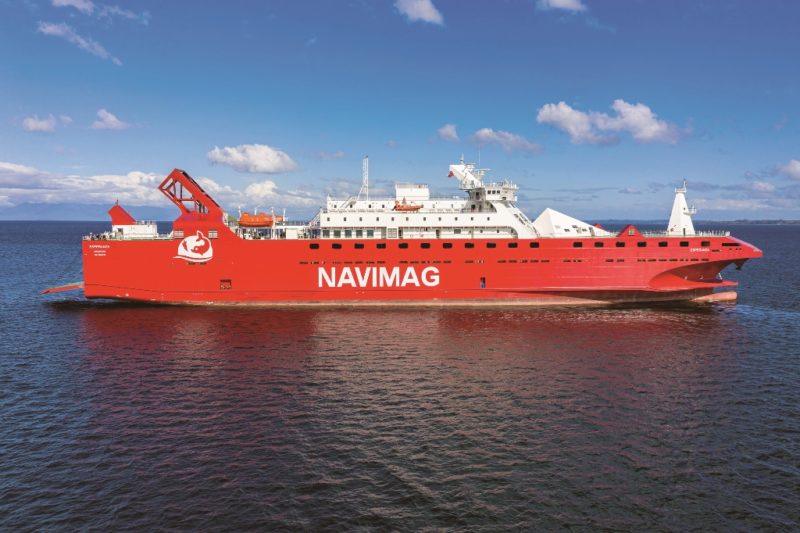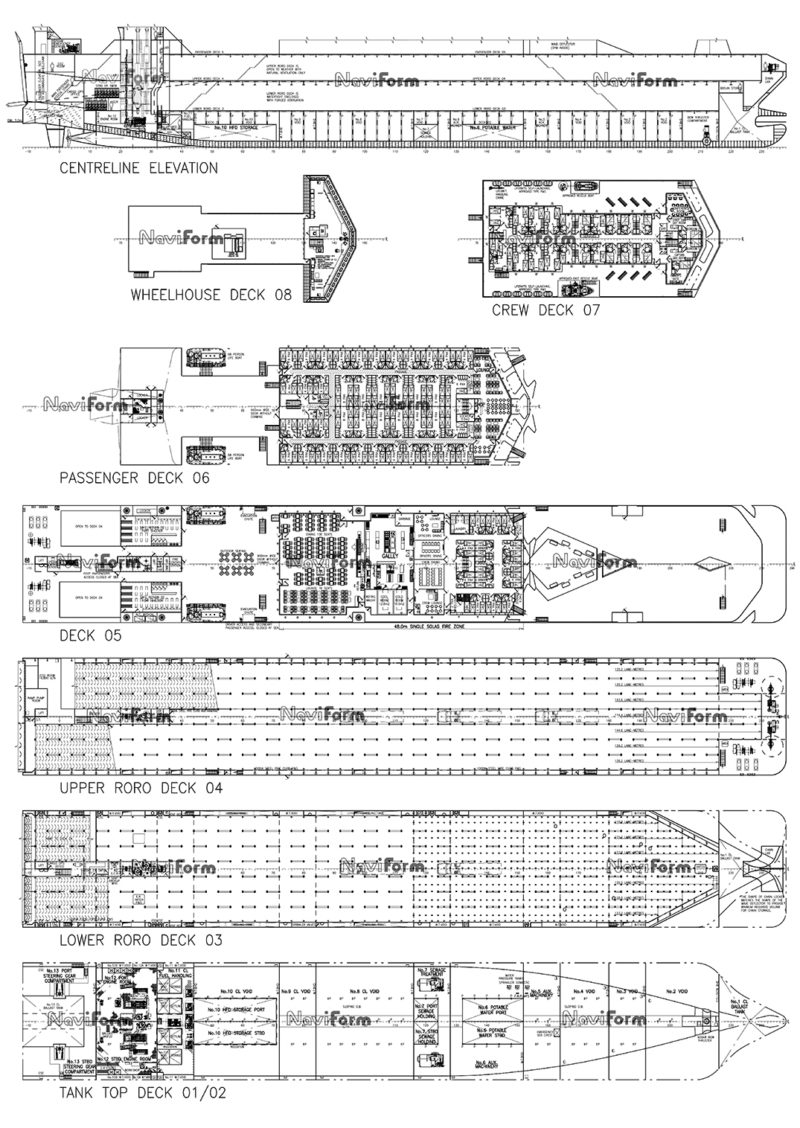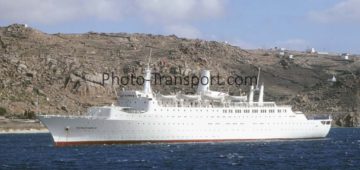 Every so often a completely different design of an otherwise reasonably standard type of ship emerges onto the scene, often accompanied by that well-known “marmite affect” of “love it” or “hate it.” Well, with all the furore around the globe created by the pandemic in 2020, a striking new design of Ro-Ro ship was quietly delivered in August 2020. The ship has well and truly broken the mould but there is definitely a method to her creation.
Every so often a completely different design of an otherwise reasonably standard type of ship emerges onto the scene, often accompanied by that well-known “marmite affect” of “love it” or “hate it.” Well, with all the furore around the globe created by the pandemic in 2020, a striking new design of Ro-Ro ship was quietly delivered in August 2020. The ship has well and truly broken the mould but there is definitely a method to her creation.
Unforgiving Environment
The newbuild was instigated by Navimag (Naviera Magallanes S.A.), a ferry operator in Chile that operates two routes in Patagonia carrying passengers and vehicles. One service plies between Puerto Montt and Puerto Natales, calling at Puerto Eden (a 4-day voyage) and the other links Puerto Montt with Puerto Chacabuco. The company also offers services from Puerto Montt and Puerto Chacabuco to Laguna San Rafael. Navimag was formed in 1979 when cargo services between Puerto Montt and Punta Arenas commenced. Passenger services to Puerto Natales and Laguna San Rafael were added in 1985. The Ro-Ro services are the primary means of connecting the Aysén and Magallanes regions with the rest of Chile. The main passenger service operates October-April when travellers can marvel at the scenery of the Patagonian Fjords. The Puerto Montt-Puerto Natales voyage offers a view of distant glaciers, dramatic cliffs, wind-sculpted forests and snow-capped volcanoes. Highlights also include the open sea passage on the Golfo de Penas (Gulf of Sorrow), passing through Angostura Inglesa, calling at Puerto Eden and seeing the coast of Chile’s national parks, including Corcovado, Isla Magdalena, and Laguna San Rafael. The ships sail Puerto Montt-Puerto Natales every Saturday and Puerto Natales-Puerto Montt every Wednesday. Until now, Navimag has operated a somewhat eclectic fleet of secondhand Ro-Pax and Ro-Ro vessels, with the passenger capabilities often added to Ro-Ro purchases where required. In 2000 the 2,574gt/1977-built former Maersk Flanders joined the fleet and was converted from a Ro-Ro ship to a Ro-Pax, emerging as the 9,951gt Magallanes. She was later renamed Evangelistas in 2007. Built as the Admiral Atlantic, the ship also carried the names Romira, Duke of Flanders, Maersk Friesland, Friesland, Magallanes and Evangelistas and was sold for demolition at Alang in 2020 and sailed there as the Angelis. The 3,563gt/1976-built Amadeo 1 joined the fleet in 2008 and was built as the Seaspeed Dana. She saw North Sea service, also whilst named Dana and as Calibur 2003-2007 when operating for Ferryways to Oostende. Other names included Stena Mariner and Excalibur.
On 18th August 2014 the Amadeo 1 came to grief whilst en-route to Puerto Montt when she struck a rock in the Kirke Channel near Puerto Natales. The incident caused the starboard side hull to be breached and the ship slowly capsized. Sadly, she was carrying livestock among her cargo, most of which perished. In 2015 the ship was deemed unsalvageable and was scuttled to a watery grave in 2,700m of water off Diego de Almagro Island, Chile on 21st September 2015. At this time the Evangelistas was operating the Puerto Natales service with the 13,977gt/1984-built Ro-Ro ship Eden serving Puerto Chacabuco. The latter was built as the Monte Cinto for SNCM, passed to Baja Ferries in 2010 and then to Navimag in 2014. In 2016, Navimag purchased the 6,719gt/1993-built Ro-Ro ship Trinidad I to join the fleet. Formerly the Amber 1, she was refitted in Rijeka, Croatia, before joining the company. The 7,765gt/1983-built Ro-Ro ship Coyhaique also joined Navimag in 2016 and, like other ships to serve, had a history with European/UK services. Built as the Balder Vik, the ship also served under names including Bazias 7, Stena Topper, River Lune (Belfast Freight Ferries/Norse Merchant Ferries) and Hansaland (Ferryways/Smyril Line). As a further reminder of the harsh environment that the ships navigate in, during the early hours of 3rd July 2019 the Coyhaique got into trouble whilst en-route from Puerto Chacabuco to Puerto Montt. She was carrying 19 passengers, 18 crewmembers plus 244 cattle among the cargo. Everyone was evacuated (except the Captain, who reportedly committed suicide) and a huge rescue effort followed to save the cattle, with all but 17 surviving. The ship was crossing the Moraleda Canal, Puerto Aguirre, in the Aysén Region when she grounded off Isla Melchor, causing water ingress to the engine room. In October 2019 the 11,866gt/1990-built Ro-Ro ship Dalka joined the fleet having previously operated for Cobelfret/CLdN from new as their Cymbeline. The ship was a regular at Southampton, Zeebrugge and Purfleet before being replaced by new tonnage.
Winging It
On 30th March 2017 a $30 million order was confirmed for the first of two Ro-Pax newbuilds for the Navimag Fleet. The project required a non-conventional design and that is precisely what the outcome was. Close collaboration was needed to ensure that the equipment ordered was proportional to the ship and route requirements, plus that both the operating and environmental performance met the high standards required. NaviForm Consulting & Research of Vancouver, Canada, had been tasked with the job of drawing up a design for the newbuild whilst the order for the vessel was placed with Guangdong Bonnyfair Heavy Industry Ltd., Xiaohu Island, Huangge Town, Nansha District, Guangzhou, China and the vessel was assigned the Yard No. 229.
The shipyard was founded in 1985 and specialises in a multitude of ship types including ferries and Ro-Ros. The steel cutting began on 29th January 2018, the keel laying ceremony took place on 6th July 2018 and the launch followed on 20th June 2019. Various media sources were reporting the ship’s delivery as 16th March 2020 whilst other documentation stated 23rd June 2020. In the event, handover took place in August 2020.
Either way, this was just one of many deliveries that were delayed by the global pandemic. Hull 229 received the name Esperanza, Spanish for hope or expectation. The 18,604gt, 4,924dwt and 13-knot ship arrived at her new home of Puerto Montt on 10th September where crew training and trials commenced. The Esperanza has an overall length of 150.00m (136.80m at the waterline), a 23.00m beam and a design draught of 5.00m. The ship’s profile is truly exceptional, arguably even more radical than Ulstein’s X-Box hull form.
The design had been under development by Navi Form Consulting & Research Ltd., based in Vancouver, Canada, for some time. The company was formed in 1996 and, as Naval Architects and Marine Engineers, handles design work, feasibility studies, concept to class packages, production data and more besides. The design includes a winged bow form, arguably the ship’s most striking feature. The concept of the form of the new ferry is based on two separate advantages that the design provides; Primarily the wing, situated just above the waterline, provides a divide between the above and below waterline forms.
This enables increased volume for cargo, as evident in the Esperanza’s large Ro-Ro capacity, while maintaining a slender and extremely efficient form beneath the waterline. Secondly, the wing acts as a damper in the pitching motions of the vessel in heavy seas, reducing the amplitude of the motions and associated slamming by around 50%.
This is achieved by the wing submerging within oncoming waves and resisting the typical motions of a bow rising and falling as the displacement increases when the bow cone slams into oncoming waves. The wings essentially cut into waves and are shaped to produce inverted vertical force that prevents the bow from raising over the wave and then crashing into the next one. This has been proven in several separate model test programmes spanning 20 years of research. The design works best for the low weight/high volume payloads typically found on passenger and Ro-Ro vessels. The Esperanza needs only 2,500kW of power to sail at 13/14 knots, while having a 1,800 lanemetre freight capacity on only two decks. Ultimately the design reduces hull resistance, resulting in increased speed or a lower power usage/fuel consumption.
The new ship is also the first example of a Ro-Ro vessel boasting an upper freight deck that extends all the way to the bow at full width. Once the onlooker has finished marvelling at the bow profile, attention then turns to the superstructure that shows the exoskeleton design applied to the ship overall. The prismatic topside elements, including the forward deckhouse, are intended to reduce aerodynamic drag. Even the forward mast has a robust triangular form whilst the clean forward deck lends itself to being the perfect observation area in the Patagonian fjords (weather permitting) as well as providing the heli-deck winching zone.
Taking the Service Forward
The introduction of the Esperanza has allowed Navimag to strengthen its commitment to the customers, increasing cargo capacity by 30% with one ship alone (equivalent to 55 trucks in each direction) plus strengthening service flexibility for the aquaculture industry, which allows the company to mobilise partial batches of cargo on the twice weekly sailings.

The cargo spaces are divided between Deck 3 (947 lanemetres) and Deck 4 (841 lanemetres). The main Ro-Ro deck 3 can accommodate 43 trailers or 137 cars whilst the upper level on deck 4 can cater for 154 cars or 50 trailers. These figures assume that the trailers are 18m long with the car equivalent units being 6m long. Access to the ship is via a full width stern ramp. A fixed ramp on the port side leads up to Deck 4 which is, as mentioned earlier, the full length of the ship. Deck 3 has a deck area of 2,841m3 and an axle load of 20t whilst Deck 4 has an area of 2,523m3 and an axle load of 15t. Both levels have a clear height of 4.6m.
Another unique feature of this ship design is the pillarless nature of both freight decks, enabling a diverse range of cargo and ease of loading and unloading the vessel. This layout was accomplished by strengthening the outboard structural members through finite element analysis.
Due to the nature of the route served, there are void spaces between the vehicle deck walls and the outer skin of the ship whilst Deck 1 is divided into 13 compartments/void spaces. Treatment/storage tanks are located in Nos. 6 &7, the Heavy Fuel Oil bunkers are stored in No.10 and the fuel handling equipment is in No.11. Compartment No.12 is the machinery space with No.13 containing the steering gear and a ballast tank.
The Esperanza is powered by two Wärtsilä W9L20 main engines built under licence by the Wartsila Qiyao Diesel Company Ltd. (Shanghai). These 9-cylinder units have a piston stroke of 280mm, a cylinder bore of 200mm and each operate at 1,000rpm at their maximum continuous rating (MCR) of 1800kW. The engines each drive a Flender GMBH SCV 680 gearbox with a gear ratio of 5.682 and an MCR of 1,800kW. The propeller shafts are manufactured by T-Marine (Nantong) Mechanical Manufacturing Co. Ltd. and the propellers are Wartsila 4D845 controllable pitch models, manufactured by Wartsila CME Zhenjiang Propeller Co. Ltd. The generators are 800kW Cummins PM734B2 manufactured by Cummins Generator Technologies China. The system onboard is designed for optimal efficiency with low levels of exhaust emissions.
Another NaviForm innovation is contained within the propulsion area of the ship in the form of new geometry stern bulbs that spin the flow of water into the propellers counter to their rotation. The design was model tested at the National Research Council Canada towing tank in 2006 and was shown to increase propeller efficiency by approximately 10%. The higher the coefficient affecting propeller efficiency, the higher the propeller efficiency. The typical value for this type of vessel is 0.15 and can go as high as 0.22. However, the tank testing produced readings of 0.43, an unheard-of result, so much so that it was checked and checked again. This new geometric feature led to extensive research of optimising stern bulb form to maximise propeller efficiency.
The Esperanza has an Energy Efficiency Design Index (EEDI) that meets present and future IMO targets without the need to reduce speed. Overall, fuel savings are claimed to be around 20%, with the bow and the stern bulbs contributing roughly half each.
The main passenger and crew facilities are on Deck 5 for 274 passengers (375 maximum) and the crew of 22 (10 Officers/12 crewmembers). The maximum complement of crew is listed as 48. Aft of the 48m long superstructure is the exoskeleton style raked main funnel with a smaller funnel at a corresponding rake located aft of this above the stern. The latter carries the exhaust system for the emergency generator set on deck 5. A section of the deck between the funnels is also open to Deck 4 below. Either side of the main funnel is a shelter area for use during a “safe return to port” situation. Moving forward, the lifeboats and some outdoor seating occupy the open deck astern of the accommodation block.
The passenger areas inside on Deck 5 include a 130-seater dining area (port side), a 76-seat lounge (starboard side), a large galley in the centre, plus Officer, Crew & Driver dining areas (one area each) and Officer/Crew lounges forward of the galley area. The forward section houses sleeping accommodation that consists of 9 four berth and 2 two berth passenger cabins plus 3 four berth cabins for Drivers. Onboard facilities also include a Coffee Shop, Activities Room and Medical Room.
Above on Deck 6 offers a forward observation area outside and a passenger lounge and shop. The remainder of this deck is passenger cabins (28x four berth/12x eight berth and 2x six berth). Deck 7 is the crew deck with Officer and Crew cabins (1,2 and 4 berth) plus the Captain’s & Chief Engineer’s cabins/day rooms located forward midships with a conference room to port and the Owner’s Suite to starboard. One deck above on Deck 8 is the self-explanatory Bridge Deck. The prism-like structure forward of the main superstructure not only assists with the ship’s aerodynamics but also houses a gym and yoga room.
The sister ship of Esperanza was expected to be contracted shortly at the time of writing. Because of the pandemic travel restrictions, the October 2020-April 2021 passenger season was cancelled so the Esperanza reportedly entered service in November in freight-only mode.
The new arrival effectively replaced the retired Evangelistas in the fleet, representing a huge leap forward in the type of ship employed. With a cruising speed of 13 knots, the Esperanza can sail from Puerto Montt to Puerto Natales in the Magallanes region in 63 hours. Most of the route is in the narrow and twisting Patagonia inside passage, followed by around 80-100 nautical miles in the open ocean where the weather can be severe.






Comments
Sorry, comments are closed for this item